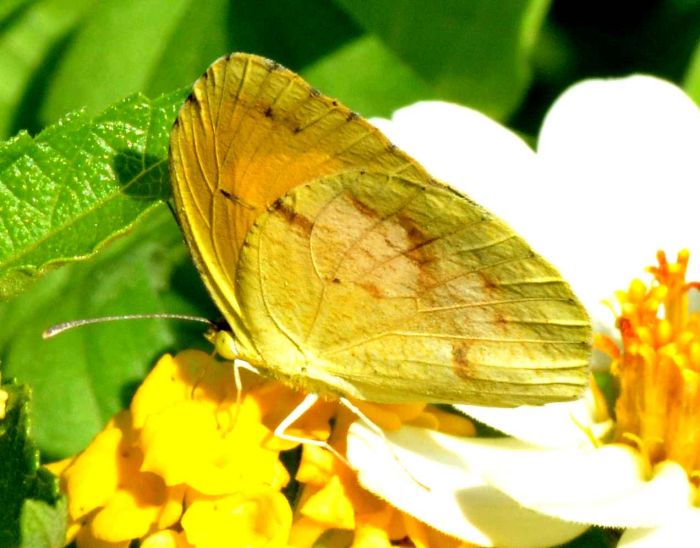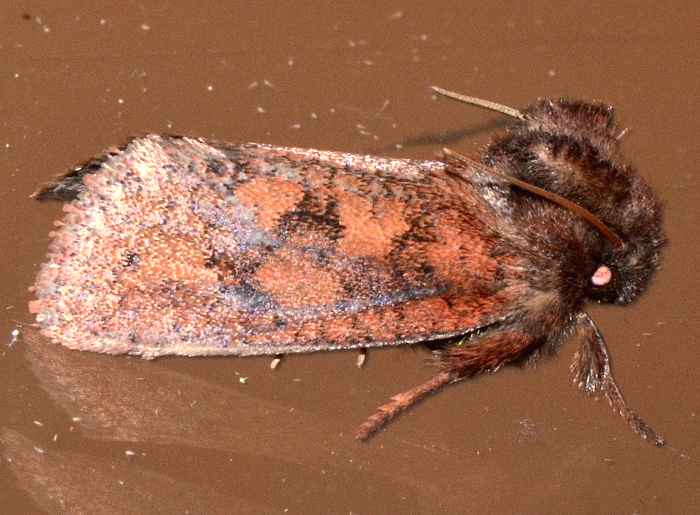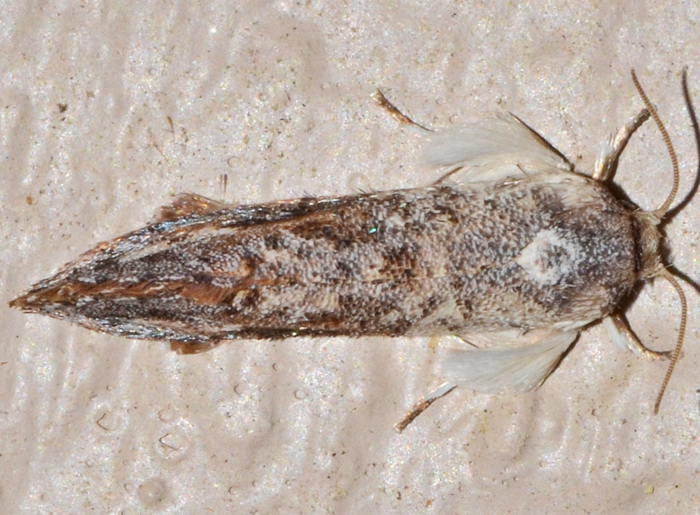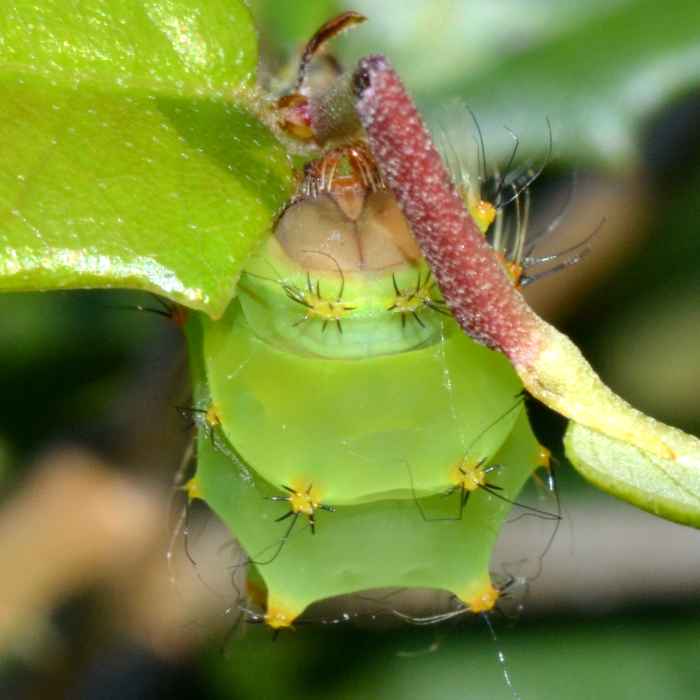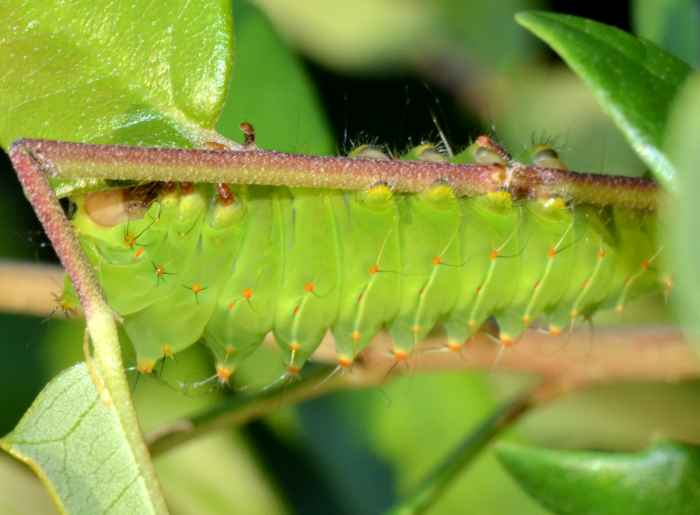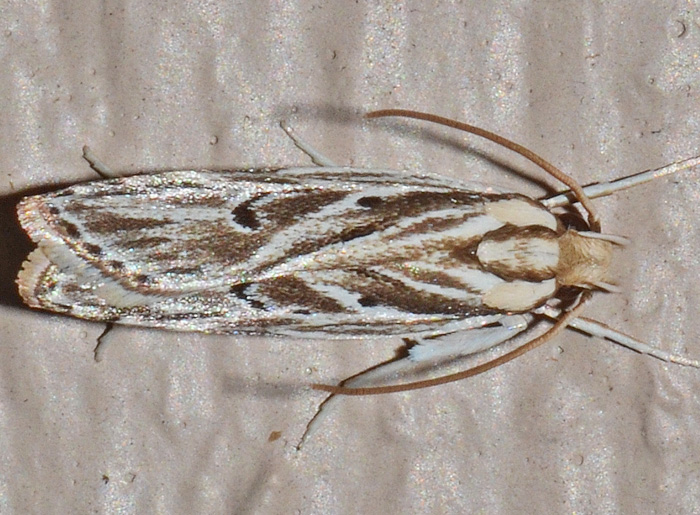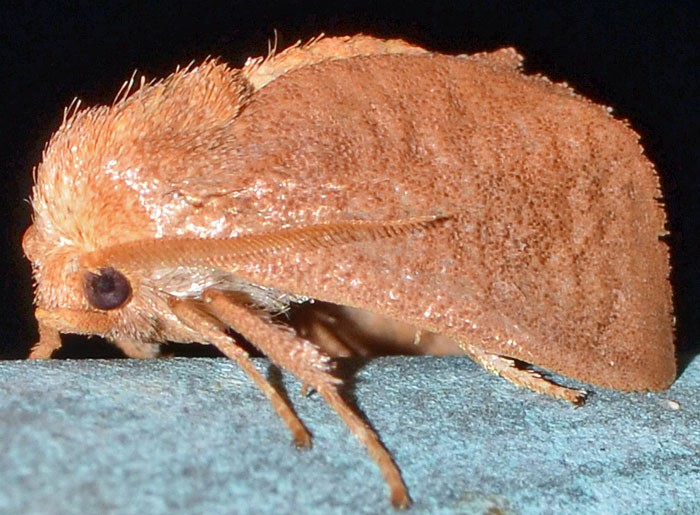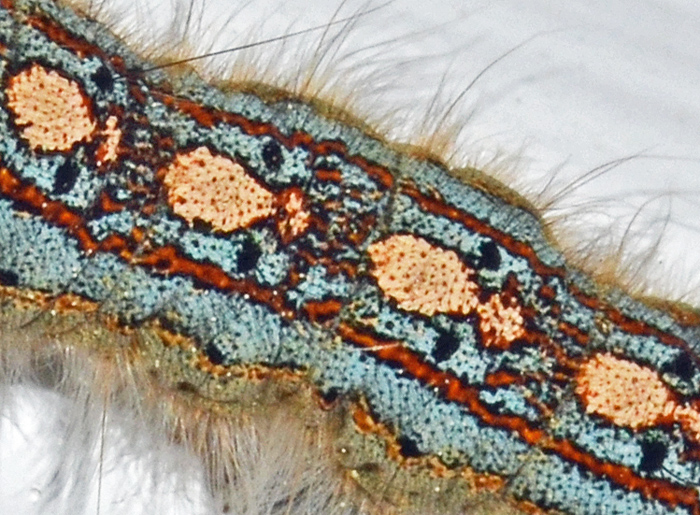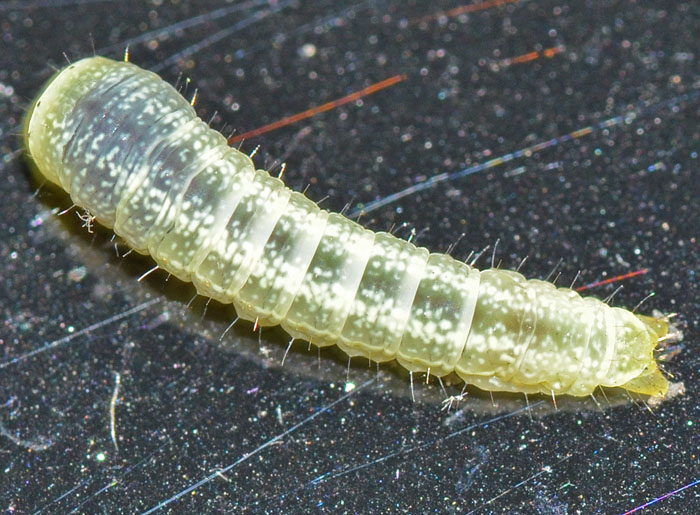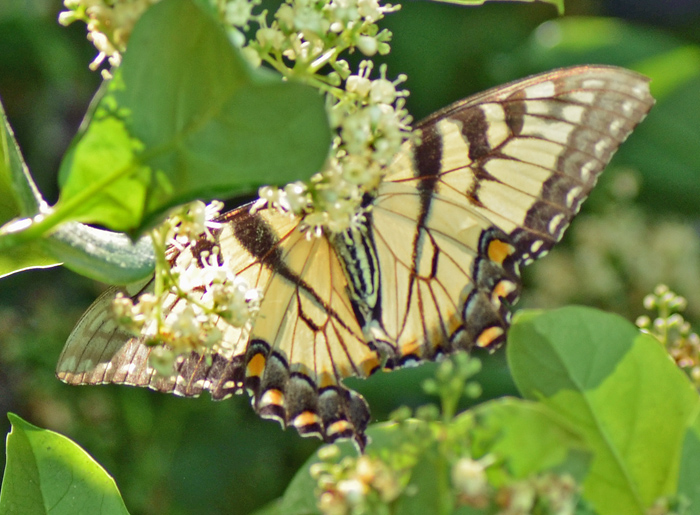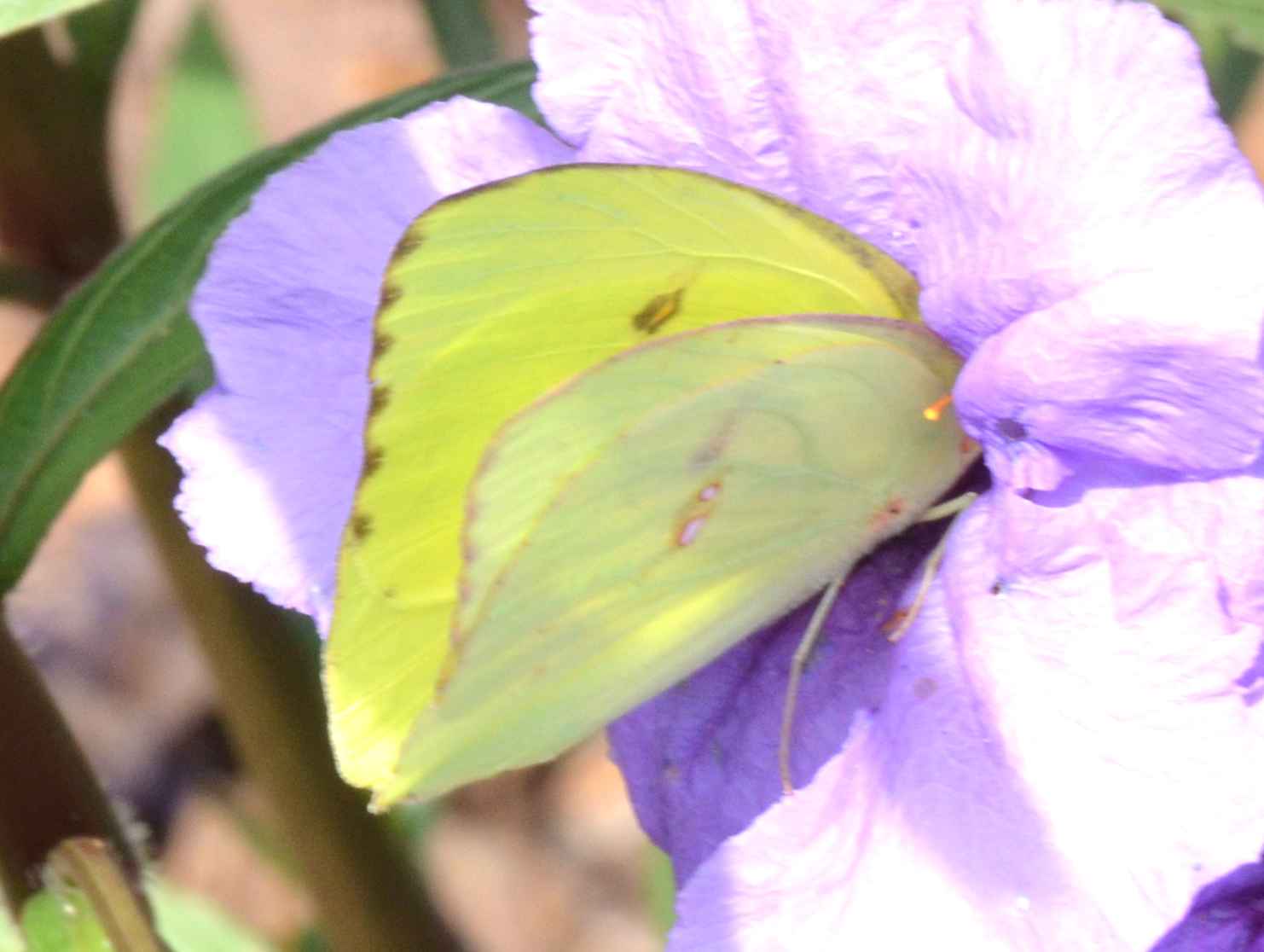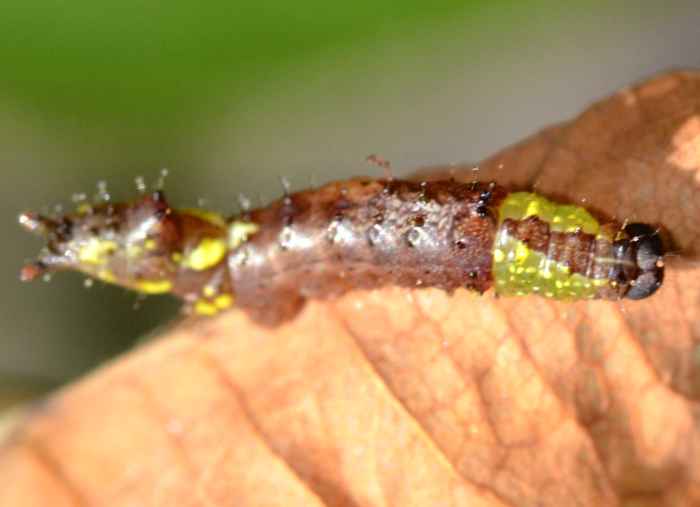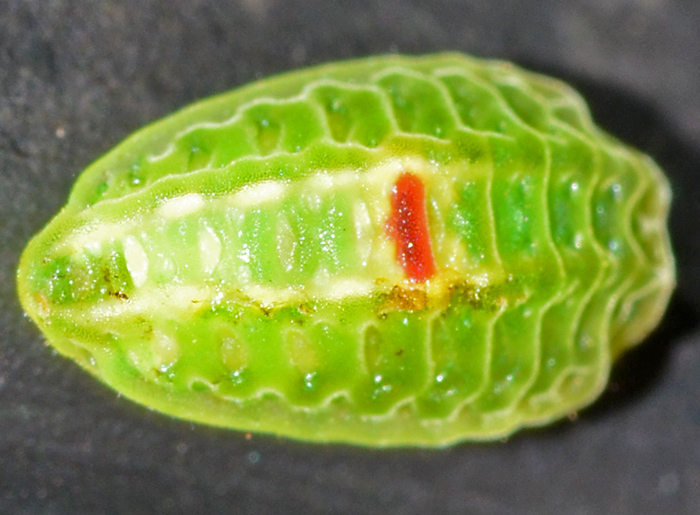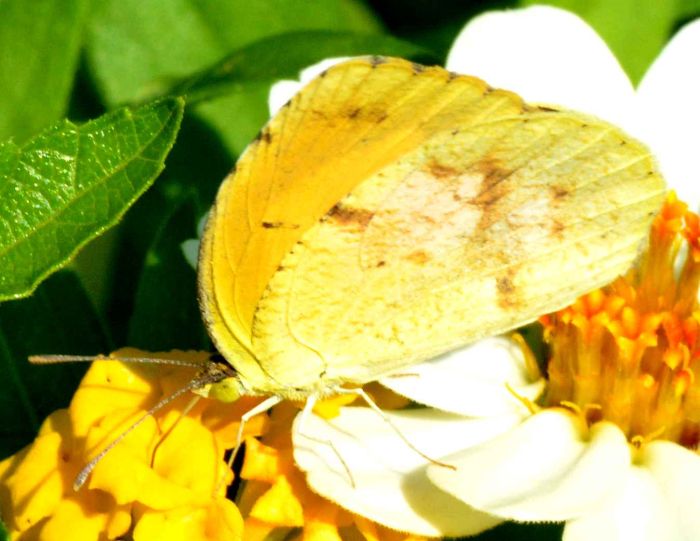 Abaeis nicippe (Sleepy Orange). | The Sleepy Orange (Abaeis nicippe) is a very common, brightly colored butterfly. Males have fewer dark markings than females. The second link has excellent information on the different color variations throughout the year. The butterflies in this family (Pieridae) are usually called 'whites' or 'sulphurs'.
bug guide (this photo): http://bugguide.net/node/view/562187 Carolina Nature by Will Cook: http://www.carolinanature.com/butterflies/sleepyorange.html | ||
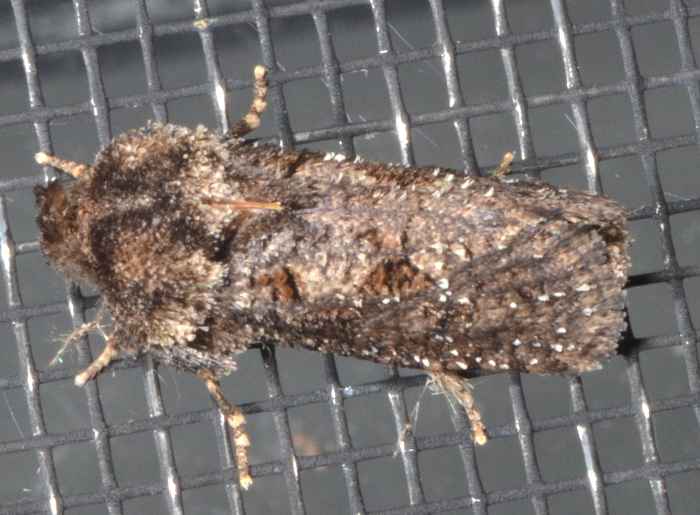 Acrolophus sp. (Tubeworm Moth) ♀. | The thorax and head of Tubeworm Moths (Acrolophus sp.) is typically hairy. While resting they hold their wings roof-like over the abdomen. The genus has over 50 species in North America. bug guide: http://bugguide.net/node/view/18147 | ||
 Acrolophus plumifrontella - Hodges#0372 | I couldn't find much information on the Eastern Grass-tubeworm Moth (Acrolophus plumifrontella). The small photos show a different specimen (6/21/12).
bug guide (this photo): http://bugguide.net/node/view/1100827 bug guide (small photos): http://bugguide.net/node/view/661463 | ||
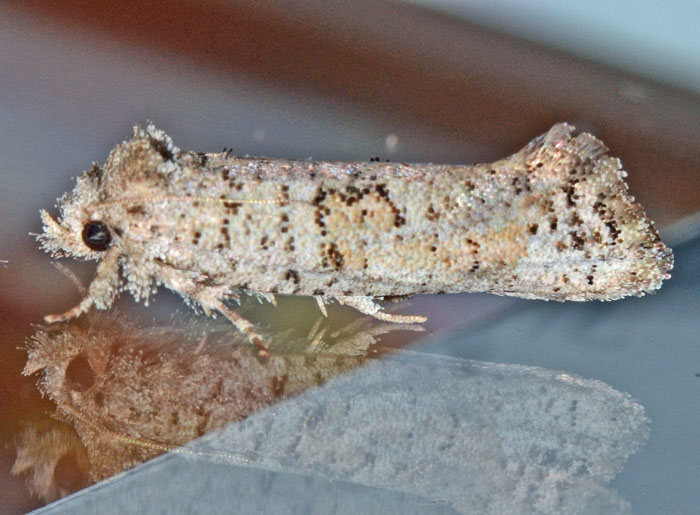 Acrolophus forbesi - Hodges#0353. | This is probably Acrolophus forbesi.
bug guide (these photos): http://bugguide.net/node/view/689259 Barcode of Life Data Systems (BOLD): http://v2.boldsystems.org/views/taxbrowser.php?taxid=126692 | ||
 Acrolophus mycetophagus - Hodges#0367.1 | Quite an interesting looking moth. The hindwings are dark brownish-gray and the head may or may not be covered with very long white hair-like scales. The species name means "fungi or mushroom-eating" and refers to the larval diet.
bug guide (these photo): http://bugguide.net/node/view/1220502 | ||
 Actias luna (Luna Moth). | Okay, I am pretty sure about this one.
I'd say it's a luna moth (Actias luna). This moth was huge and has a very striking tail. Its width is about 4 inch. Their caterpillars feed on sweet-gum trees which I have in my yard. Notice the eyespots on the wings. The adult moth has no mouth, does not eat all, and lives only ~1 week. Its sole purpose is to mate. wikipedia: http://en.wikipedia.org/wiki/Luna_Moth | ||
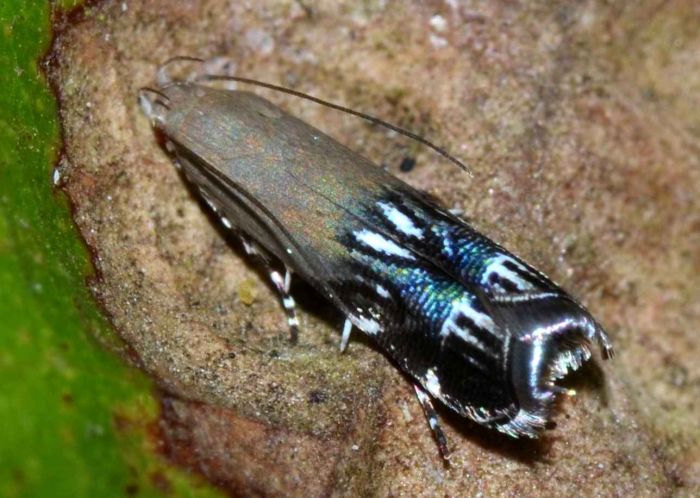 Anacampsis levipedella - Hodges#2241 | Very small moth on a tree leaf. The moth circled frantically around the brown spot for several seconds before settling down. bug guide (this photo): http://bugguide.net/node/view/547099 moth photographers group: http://mothphotographersgroup.msstate.edu/species.php?hodges=2241 | ||
 Anisota sp.. | A fairly large Oakworm Moth. Possibly A. stigma or virginiensis. Their caterpillars are commonly knownas oakworms and defoliators of oaks. bug guide (this photo): https://bugguide.net/node/view/1547438 wikipedia: https://en.wikipedia.org/wiki/Anisota | ||
 Antheraea polyphemus - Hodges#7757 (Polyphemus Moth) - imm. | This common caterpillar is a larval Antheraea polyphemus. It is bright green, with reddish and silvery spots, and oblique yellow lines running through the spiracles on abdomen. The head and true legs brown. They can be found throughout the lower 48. The caterpillar of the luna moth is superficially similar. The adult moth is large and brown with a prominent, round eyespot near the middle of the forewing.
bug guide (these photos): http://bugguide.net/node/view/664723 | ||
 Atteva aurea - Hodges#2401 (Ailanthus Webworm Moth). | What a beautiful little moth! Its forewings are orange with several large black and white rosettes. The detailed pattern apparently varies among specimens. Adults take nectar from flowers. The presence of this originally tropical moth in the eastern US is closely related to the ornamental plant Ailanthus altissima which is now
considered one of the most serious weeds in the US.
bug guide (this photo): http://bugguide.net/node/view/1349210 wikipedia: https://en.wikipedia.org/wiki/Ailanthus_webworm V. O. Becker, Rev. Brasil. Entomol. 53, 349, 2009: http://www.scielo.br/pdf/rbent/v53n3/07.pdf | ||
 Automeris io - Hodges#7746 (Io Moth) ♀. | ... and here is a female Io Moth. Again I didn't wait long enough to see the striking eyespot patterns on the hindwings of this big moth (wingspan up to 8 cm). Io Moth populations have declined in the Gulf States (with the exception of Louisiana) and elsewhere since the 1970s. bug guide (this photo): http://bugguide.net/node/view/1221949 UF: http://entnemdept.ufl.edu/creatures/misc/io_moth.htm | ||
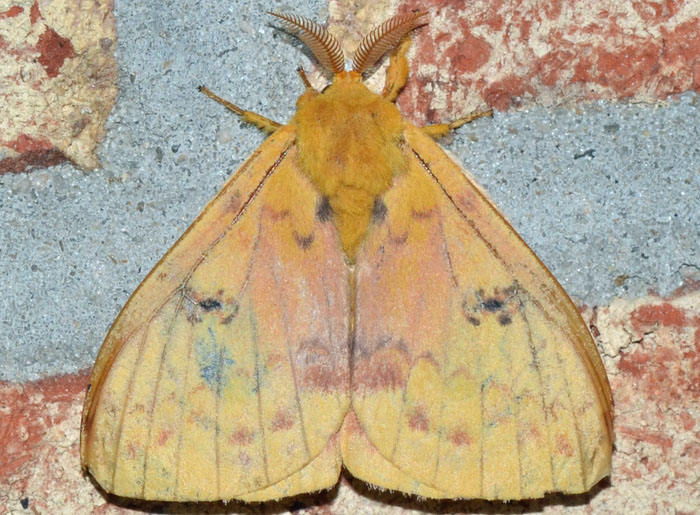 Automeris io - Hodges#7746 (Io Moth) ♂. | The Io (or Peacock) Moth has two large, black and blue eyespots on their hindwings, which cannot be seen on my photo. This distinctive pattern is quite amazing and I regret that I didn't wait longer to see it. The caterpillars of this species are usually found in groups. Their color is orange early on and then changes to a pale blueish green with clusters of spines. The larvae may "sting" if handled.
bug guide (this photo): http://bugguide.net/node/view/981781 | ||
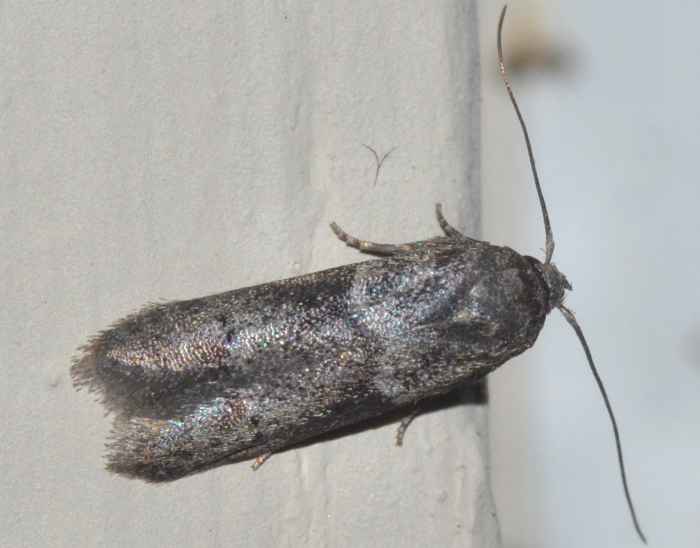 Blastobasis sp. (?) (Scavenger Moth). | This moth belongs to the family of Casebearer Moths. The name refers to the larvae living in cases of plant material, frass, and silk. It is probably Blastobasis sp. (>10 species in the US) or Pigritia sp. A bugguide expert pointed out that they are very difficult to identify solely based on a photo. bug guide (this photo): http://bugguide.net/node/view/572865 | ||
 Calycopis cecrops (Red-Banded Hairstreak). | This is a very small butterfly called Red-Banded Hairstreak (Calycopis cecrops). The genus has two species in North America but only one is likely to be found in Florida.
bug guide (small photo below): http://bugguide.net/node/view/556298 | ||
 Dryadaula terpsichorella - Hodges#0307.1 | The little Dryadaula terpsichorella is an introduced species to Florida. The literature states "The common name is derived from characteristic circular gyrations, with a crablike sideways gait". I had this specimen originally listed as Caribbean scavenger moth, which seems incorrect. bug guide (this photo): http://bugguide.net/node/view/658192 | ||
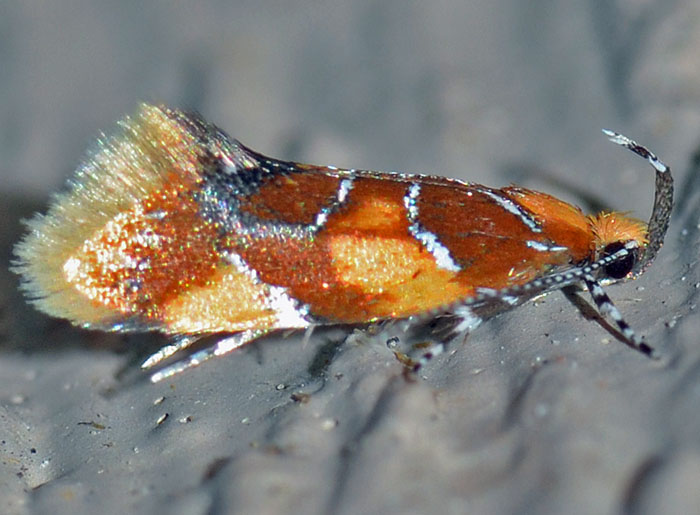 Epicallima argenticinctella - Hodges#1046 | This concealer moth immediately caught my attention. Although small, the pretty colors were quite striking. It was attracted to our porch lights and didn't move much for over an hour. bug guide (this photo): http://bugguide.net/node/view/983101 | ||
 Euclea nanina - Hodges#4697.1 (Nanina Oak-Slug Moth). | This is, in my opinion, a very unusual looking moth. Apparently it is difficult to distinguish adults of Euclea delphinii and E. nanina. Individuals of both species have varying amounts of green on the forewing and their ranges overlap from South Carolina to Florida, west to Texas but are overall not very common. bug guide (this photo): http://bugguide.net/node/view/1205801 | ||
 Eupragia hospita - Hodges#0953. | Another Southern moth. The second link states that specimens "vary greatly in appearance depending upon wear. Fresh specimens have distinct maculation heavily shaded with brown and gray-brown; worn specimens lose much of the
brown scaling. The head and thorax of some specimens have become greased, indicating that the larvae possibly are internal feeders."
bug guide (these photos): http://bugguide.net/node/view/1130250 R. W. Hodges, J. Lepidop. Soc. 23, 23, 1969: http://tinyurl.com/hodges1969 | ||
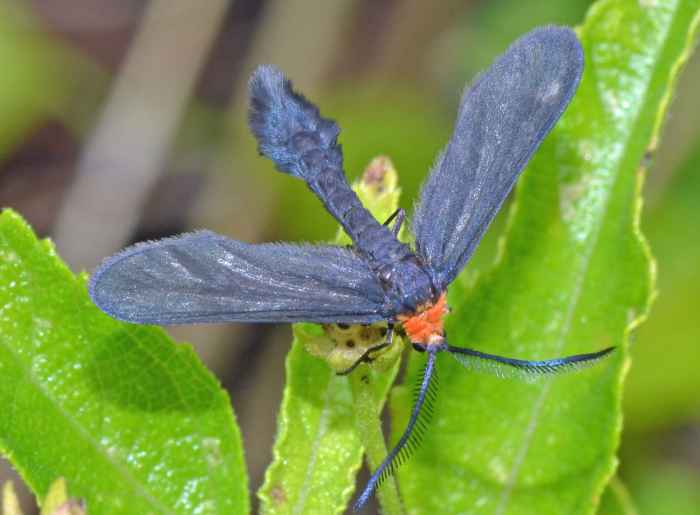 Harrisina americana - Hodges#4624 | The Grapeleaf Skeletonizer (Harrisina americana) has narrow, completely black wings which it holds spread out and away from body at rest. Its collar is orange/red and the tip of the abdomen has prominent tufts of scales. Their larvae feed on grapeleafs, redbud, and virginia creeper. We definitely have the latter, unpleasant plant in our yard. Anyway, a beautiful moth. bug guide (this photo): http://bugguide.net/node/view/686125 | ||
 Heterocampa guttivitta - Hodges#7994 | This fairly large moth is probably Heterocampa guttivitta. Misogada unicolor looks very similar but is usually not found in Florida. bug guide (this photo): http://bugguide.net/node/view/1080382 | ||
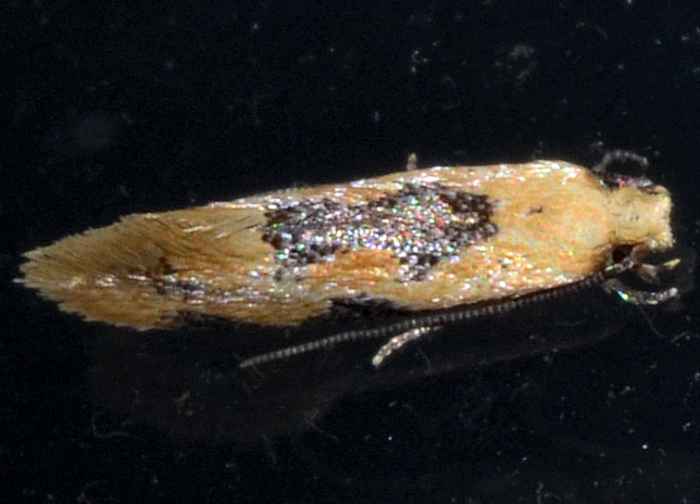 Hybroma servulella - Hodges#300 (Yellow Wave Moth). | This interesting looking clothes moth is Hybroma servulella and can be found in the Eastern half of the US. Not the greatest photo, so I hope to see this small moth again soon. bug guide: http://bugguide.net/node/view/24483 | ||
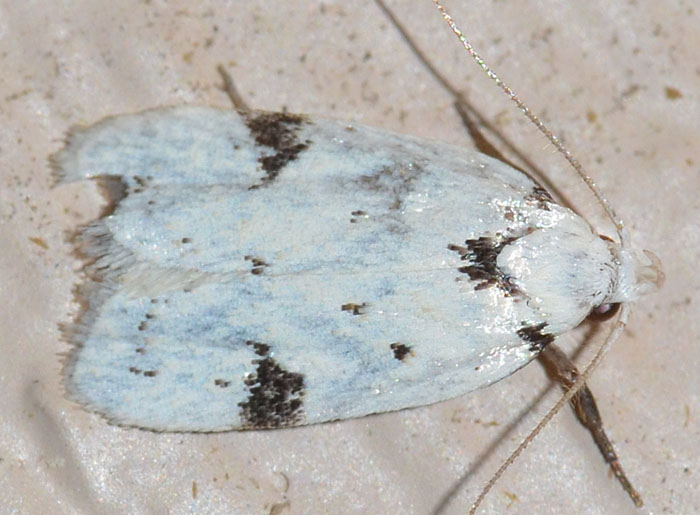 Inga sparsiciliella - Hodges#1034 | The range of this little white moth is mainly the Southeast and Texas. bug guide (this photo): http://bugguide.net/node/view/980589 | ||
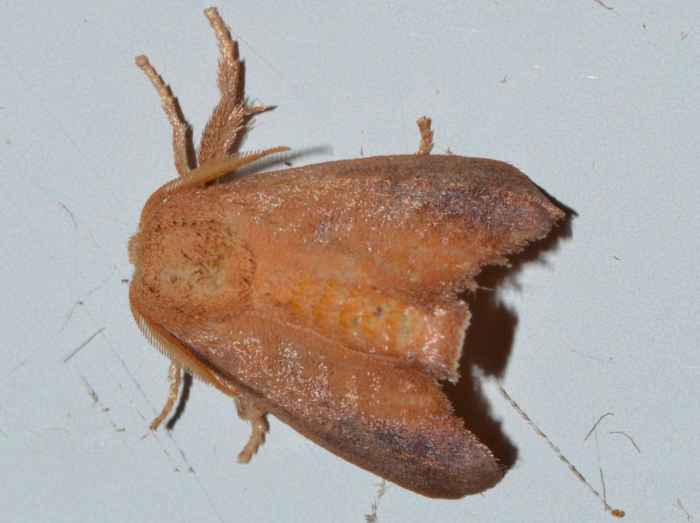 Isa textula - Hodges#4681 (Crowned Slug Moth). | Possibly a crowned slug (Isa textula). The larvae are often found on oak and create zigzagging tracks on the underside of leaves. The caterpillar is flattened and about 5/8 inch long. It is a "stinger" with specialized nettling spines. These structures are hollow and contain toxins. The small photos show a different specimen that I found on 08/19/14 around 11 pm.
bug guide (this photo): http://bugguide.net/node/view/587194 Auburn U: http://www.ag.auburn.edu/enpl/bulletins/caterpillar/caterpillar.htm | ||
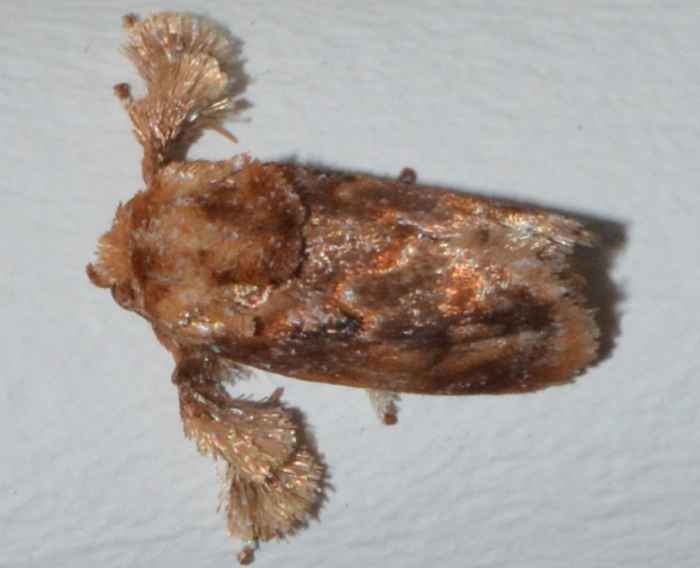 Isochaetes beutenmuelleri - Hodges #4675 | Beutenmueller's Slug Moth (Isochaetes beutenmuelleri). Long name, strange moth. This one came to the light of our living room window. bug guide (this photo): http://bugguide.net/node/view/576240 moth photographers group: http://mothphotographersgroup.msstate.edu/species.php?hodges=4675 | ||
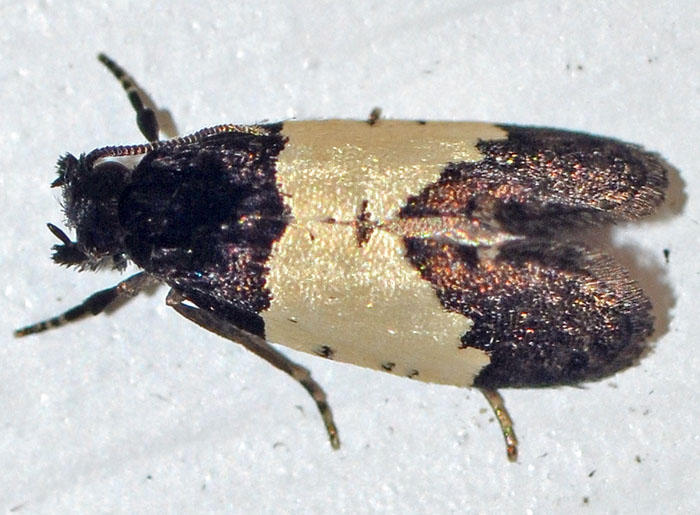 Kearfottia albifasciella - Hodges#0319 | Found throughout much of eastern North America, this little moth has a dark brown body with a central white or beige band. The species feeds on plant debris, fungus, and rotting animal as well as vegetation. The wing span is 9-10 mm.
bug guide (these photos): https://bugguide.net/node/view/1574013 | ||
 Lochmaeus manteo - Hodges#7998 | This large moth is my first find of an adult member of the family Notodontidae (Prominent Moths). Its larva can spray formic acid causing blisters or severe skin irritation for humans. bug guide (this photo): http://bugguide.net/node/view/981753 | ||
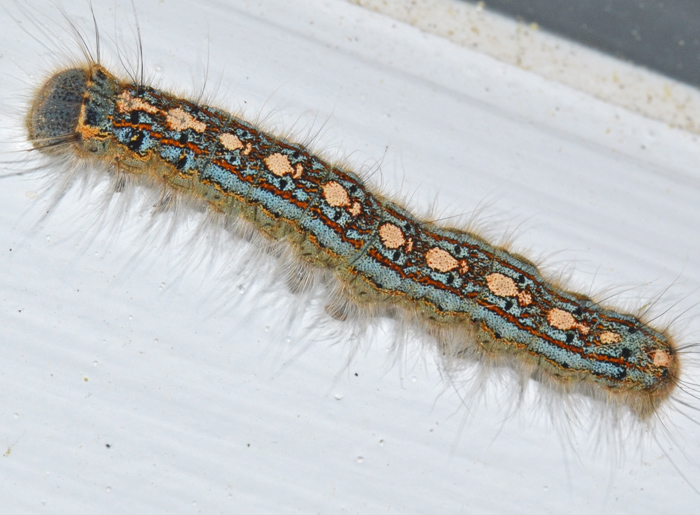 Malacosoma disstria - Hodges#7698 | Awesome colors and patterns. Forest Tent Caterpillars create silken mats on tree trunks and large branches where they congregate to molt or rest. The larvae also deposit silk in strands along which they travel to and from feeding sites; a very small version of the silk road so to speak. Unlike the Eastern Tent Caterpillar, these little fellows do not form silken tents. Click on the small photo to see a close-up of the same specimen.
bug guide (this photo): http://bugguide.net/node/view/1208700 | ||
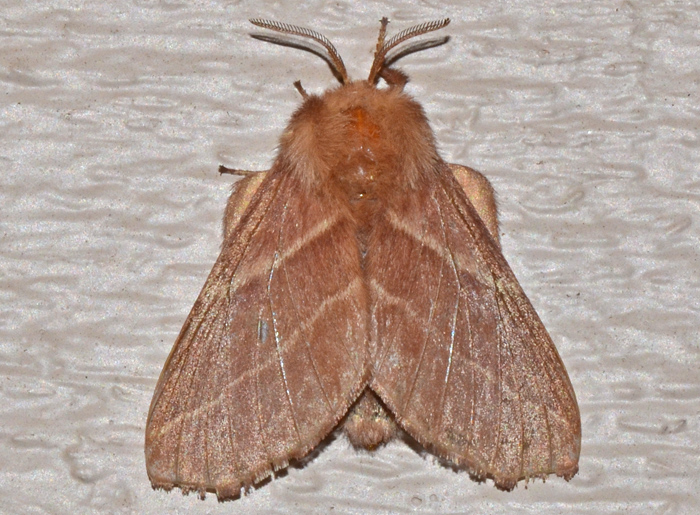 Malacosoma americana - Hodges#7701 | I was excited to finally see the moth that goes with the interesting and colorful caterpillars of this species. The chunky moth was attracted to our porch lights and had the habit of fluttering its wings while resting. bug guide (this photo): http://bugguide.net/node/view/1217982 | ||
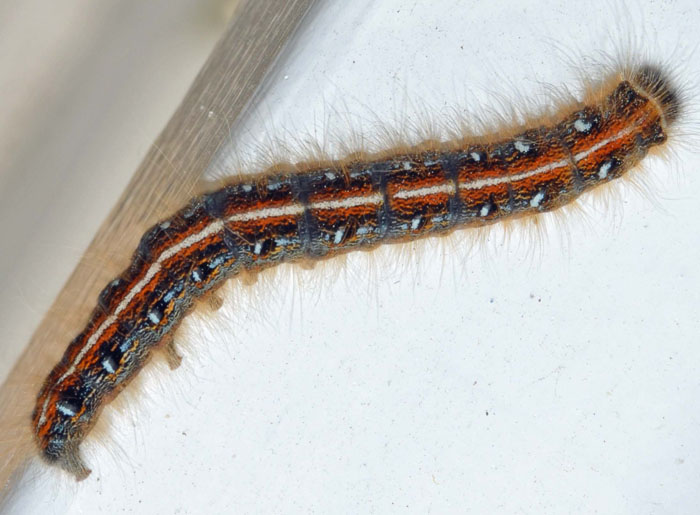 Malacosoma americana - Hodges#7701 | The Eastern Tent Caterpillar has a solid cream/white line along the dorsum (middle of the back). Its sides are marked with blue, black, orange and white whereas the face is dark. They are among the earliest caterpillars to appear in spring and this one was the first in my yard this year.
Eastern Tent Caterpillars secrete silk wherever they go and other caterpillars follow and enhance those silk trails. The trails contain a pheromone (see second link for more information). bug guide (this photo): http://bugguide.net/node/view/1053426 Social Caterpillars (T. D. Fitzgerald): http://web.cortland.edu/fitzgerald/Easterntent.htm | ||
 Marathyssa inficita - Hodges#8955 (Dark Marathyssa). | A very early example of the otherwise widespread and common Dark Marathyssa. The moth is very three-dimensional with an erect body and long, seemingly narrow wings. The wingspan is about one inch. The very similar looking M. basalis occurs in Florida as early as March, so I am slightly worried about the species identification. bug guide (this photo): http://bugguide.net/node/view/1207807 | ||
 Megalopyge opercularis - Hodges#4647 | The Southern Flannel Moth (Megalopyge opercularis) is a common sight in Florida and the Southeast. Its caterpillars are called "Puss Caterpillars" and are known to have a painful sting. Males have feathery antennae and stronger markings than females of this species. This suggests that this specimen is a male.
bug guide (these photos): http://bugguide.net/node/view/671919 | ||
 Orgyia detrita - Hodges#8313 (Fir Tussock Moth) - imm. | Citing from Wagner "Caterpillars of Eastern North America", p. 450: "The sides of the body are gray and supraspiracular warts are orange; the black middorsal stripe is flanked by yellow spots on A4-A7." The second link also describes a rather different looking, darker version of the caterpillar. The one shown here is strange because it has only three (rather than the normal four) of those distinct, beige "brushes". bug guide (this photo): https://bugguide.net/node/view/1513765 UF: https://tinyurl.com/Orgyia-detrita | ||
 Paectes nubifera - Hodges#8965 - imm. | The range of Paectes nubifera is limited to Florida and nearby states. The adult form is a brownish moth with a wingspan of about 3 cm. The two photos show the same specimen which I found on my black truck.
bug guide (these photos): http://bugguide.net/node/view/1223487 | ||
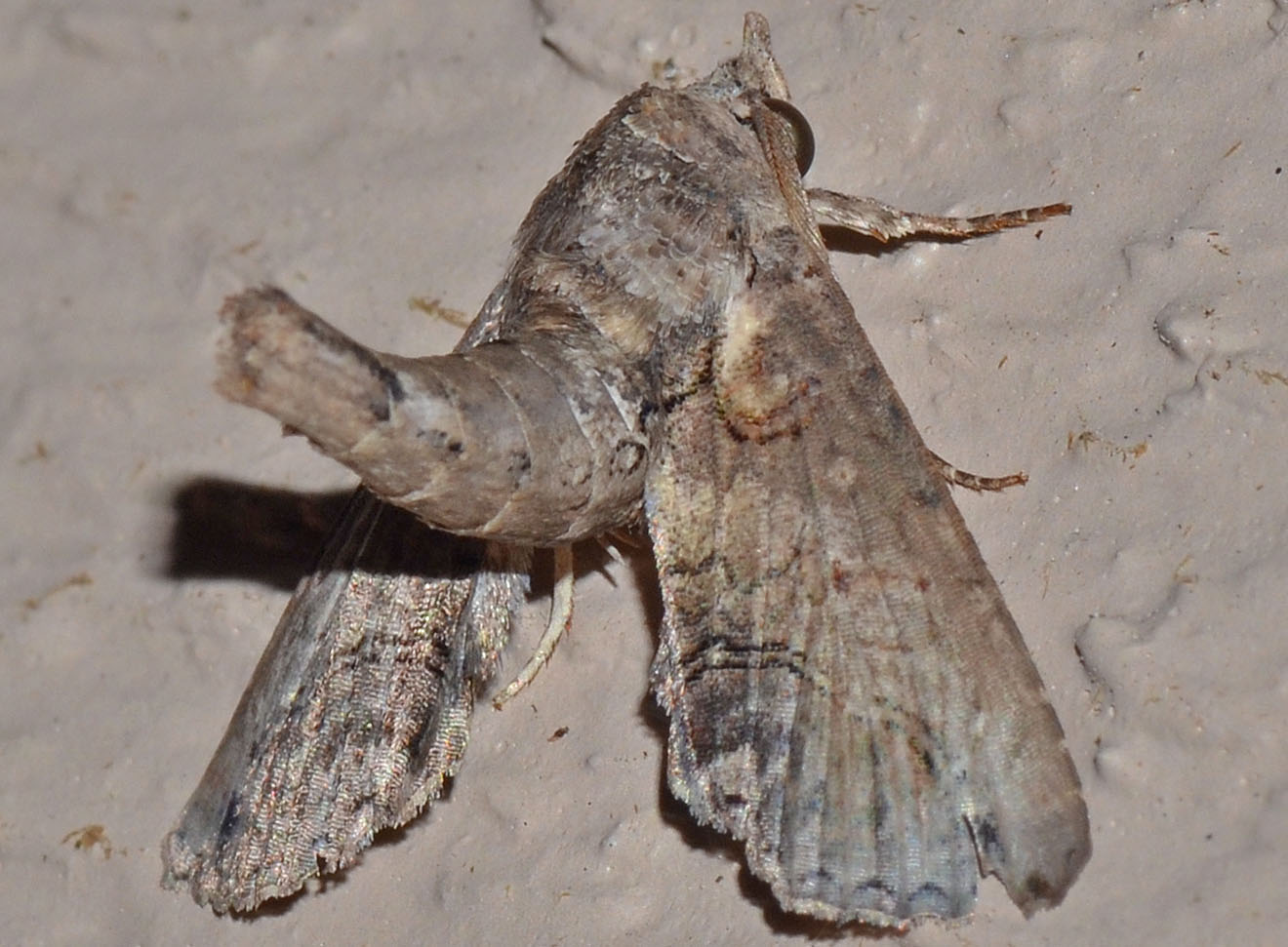 Paectes abrostoloides - Hodges#8962 | The larvae of this moth are called "Sweetgum Defoliators" but although we have several sweetgums in our yard, I have not seen the trees defoliated yet. P. abrostoloides has an unusually three-dimensional resting position. This one had its wings rather close to the wall surface and pointed its body away from the wall generating the appearance of a dried up plant structure. bug guide (this photo): http://bugguide.net/node/view/986733 | ||
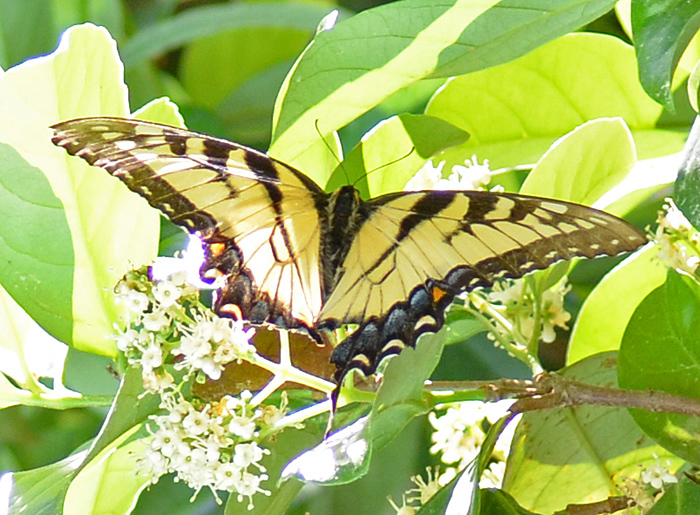 Papilio glaucus (Eastern Tiger Swallowtail) ♀. | This large and very common butterfly is an Eastern Tiger Swallowtail. They have wingspans of 8-16 cm. Females are larger and darker than males. The conspicuous band of blue spots along the hindwing is indicative of females. P. glaucus is one of a few butterfly species that produce gynandromorphs (both male and female characteristics). Usually adults fly high above the ground, which has made it difficult for me take these photos.
wikipedia: https://en.wikipedia.org/wiki/Papilio_glaucus | ||
 Phoebis sennae (Cloudless Sulphur) ♀. | The Cloudless Sulphur (Phoebis sennae) can be found in the Southeast throughout the year reaching Ontario during the summer. The small photo shows the same individual. The caterpillars feed mostly on herbaceous and woody legumes. I believe this is a female.
bug guide (this photo): http://bugguide.net/node/view/563814 bug guide (male): http://bugguide.net/node/view/136640 | ||
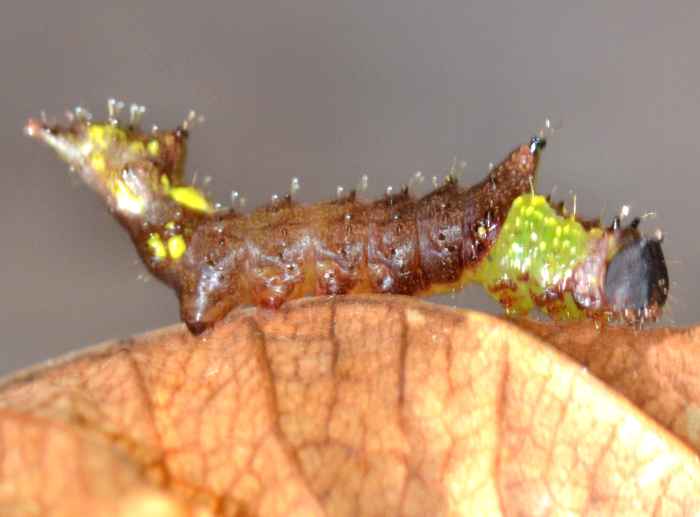 Schizura unicornis - Hodges#8007 | An interesting caterpillar of a grayish moth. This is the Unicorn Caterpillar (Schizura unicornis). Caterpillars in this genus can spray a jet of formic acid over several inches from a gland in the hump. I found this specimen on a rose leaf and luckly did not experience the formic acid welcome.
bug guide (these photos): http://bugguide.net/node/view/574803 | ||
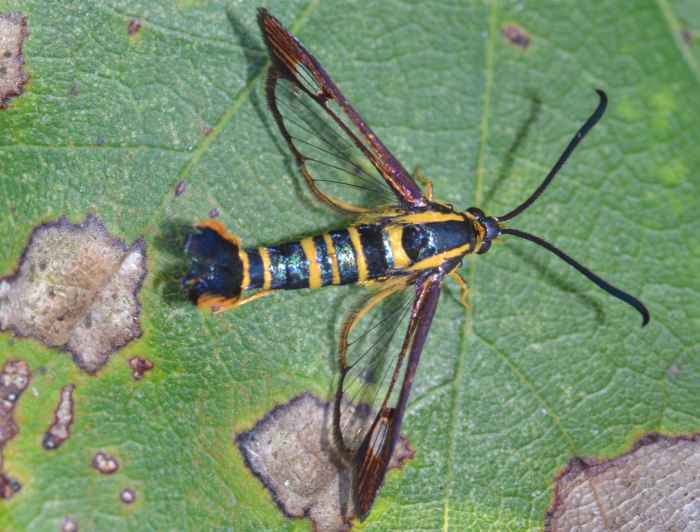 Synanthedon arkansasensis - Hodges#2575 | This is my first Clearwing Moth (Synanthedon arkansasensis). It is found in the Southeastern U.S. and Texas. Many Clearwing Moths resemble wasps and bees. bug guide (this photo): http://bugguide.net/node/view/574802 | ||
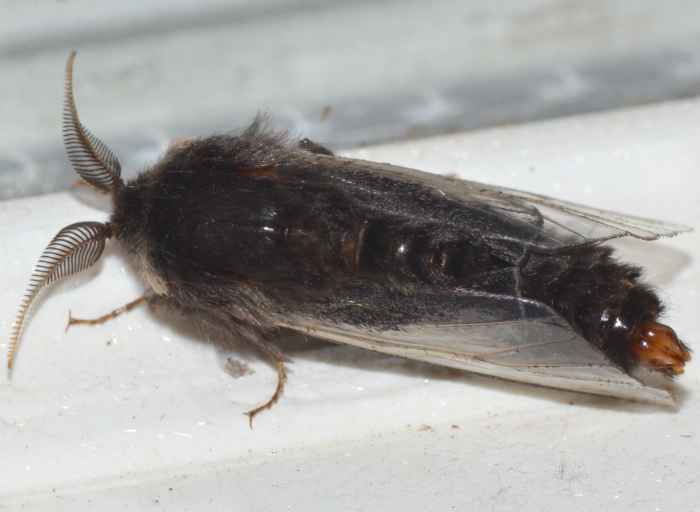 Thyridopteryx ephemeraeformis - Hodges#457 | This bagworm moth is Thyridopteryx ephemeraeformis (one of five species in this genus in the US). I am quoting the following text about its bizarre life cycle directly from the bugguide: "Larvae drag around their cases while feeding. When ready to pupate they attach the cases with silk to a branch. Males squeeze their way out, often losing much of their wing scales in the process. They seek wingless, legless females who never leave their bags. The males insert their abdomen to mate, and the females lay their eggs inside their own cases. Eggs overwinter and after hatching they disperse and begin forming their own bags." bug guide (this photo): http://bugguide.net/node/view/582050 | ||
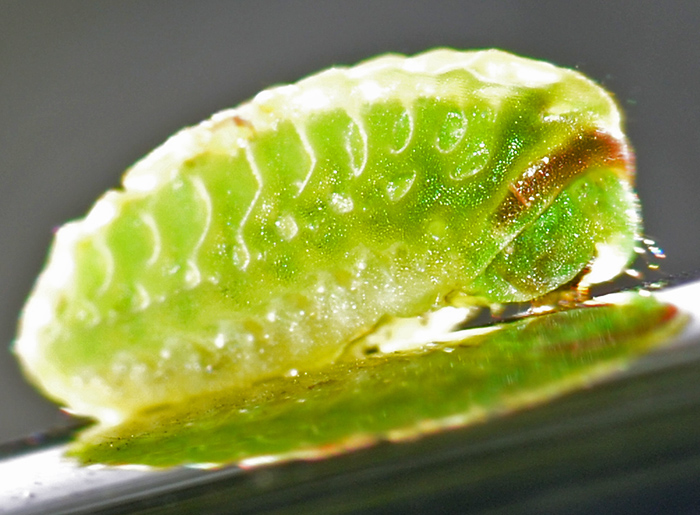 Tortricidia or Heterogenea sp. - imm. | This caterpillar surely belongs to the family Limacodidae (Slug Caterpillar Moths). It is either Heterogenea shurtleffi or Tortricidia flexuosa. I found this specimen on my truck under oak trees.
bug guide (these photos): https://bugguide.net/node/view/1538871 | ||
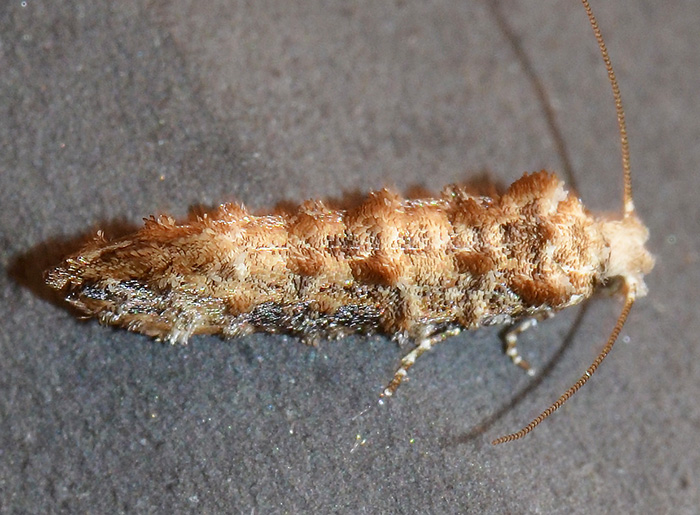 Xylesthia sp.. | A peculiar little moth that belongs to the family Tineidae. Most familiar members of this family are the clothes moths, which feed on stored fabrics and have a reputation as a household pest. bug guide (this photo): https://bugguide.net/node/view/1794218 |

